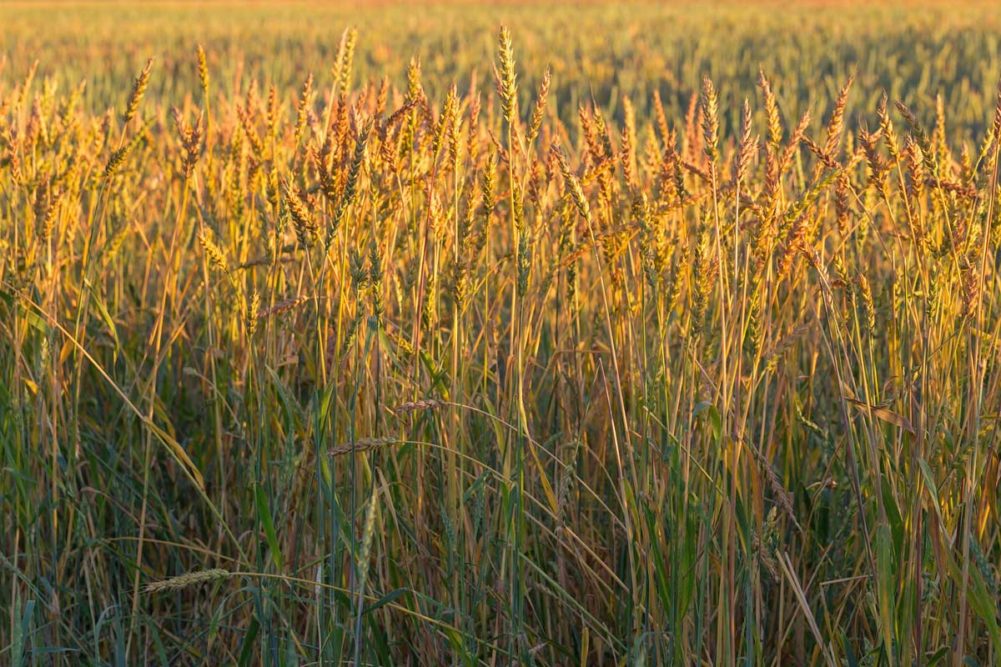KANSAS CITY — The 2020 spring wheat and durum harvests were winding down last week under the same nearly-ideal conditions in place during most of harvest. Testing indicated good quality characteristics, proteins edging higher than in 2019, and no major issues with diseases or pests.
Producers were pleased with the smooth pace of the spring wheat harvest, especially compared with the wet, frequently delayed 2019 harvest.
“With the exception of some hopefully minor ergot issues, we have a pretty decent crop with a variety of proteins,” a veteran Upper Midwest commodities analyst said. Falling numbers were good, well over 300 seconds most everywhere, she said.
The 2020 hard red spring wheat crop was 92% harvested by Sept. 13, the US Department of Agriculture said in its weekly Crop Progress report. That was a 10-percentage point advance from the prior week and equal to the recent five-year average for the date. Progress was well ahead of 75% completed a year earlier, when inclement weather dropped two inches or more of rain over the northern Plains over Labor Day weekend 2019.
The USDA indicated harvest completion by Sept. 13 was 90% in North Dakota (72% a year ago, 91% as the 2015-19 average for the date), 98% in South Dakota (95%, 98%), 97% in Minnesota (82%, 96%), 92% in Montana (67%, 88%), 94% in Idaho (88%, 94%) and 87% in Washington (83%, 94%).
Ideas were the spring wheat harvest will be essentially completed by the fourth week of September. Some later-planted fields may take a couple more weeks to harvest.
Indications were that the spring wheat crop was producing better-than-expected yields and good quality. The latest sampling data published by US Wheat Associates were based on 319 of an expected 451 samples. Testing performed by the Hard Red Spring Wheat Quality Laboratory at North Dakota State University found the average grade of samples to be No. 1 Northern Spring.
NDSU measured average crop moisture at 12.2% (12.1% as the recent five-year average), average protein at 14.6% (14.4%), dry basis protein at 16.6% (16.4%), and average dockage at 0.7% (0.7%). An average test weight of 61.6 lbs per bu topped 60.7 lbs a year ago and 61.2 lbs as the average. Thousand kernel weight of 31.7 grams topped 31 grams a year ago but fell short of 32 grams as the five-year average. The average falling number of 388 seconds topped 339 seconds in 2019 but came in below the 2015-19 average of 403 seconds.
“The color is higher than last year in terms of vitreous kernel content, with an average around 65%, so not quite into that Dark Northern Spring category,” said Erica Olson, market development and research manager with the North Dakota Wheat Commission.
“I think there are probably some isolated areas where there are some random issues such as scab, but overall, there is nothing that sticks out as a major quality problem,” she said.
But for the otherwise high-quality crop, “the stickler will be a little bit of ergot bouncing around,” an analyst said.
The extent of ergot issues was not yet known. Occurrence of the fungal disease is concerning when it comes to exporting to China, which has an ergot specification of 0.01% or less. That’s lower than other importers, such as Japan, or even domestic US mills.
North Dakota Wheat fielded some calls from producers reporting appearance of the fungal disease.
“About halfway through harvest we didn’t hear as many reports about it,” Ms. Olson said. “There is some out there, but it is tough to say how widespread and how severe it is because we’re still working on that sample collection. The good news is we have not heard much from producers or elevators on it. Especially after the 2018 crop, both producers and elevators are more aware of it, and also how to handle it in terms of segregating and cleaning out storage.”
Meanwhile the 2020 durum crop harvest was humming along at a similar pace to spring wheat and nearing its end. North Dakota durum was about 86% harvested by Sept. 13. Durum producers in the southwest and northwest parts of the state had essentially wrapped up collection. Like spring wheat, the bulk of durum was expected to be harvested by around Sept. 26 with late-planted fields collected into October if favorable weather holds.
“We had good weather and very few issues with quality,” Ms. Olson said. “The color is holding in there, falling numbers are high, damage is fairly low. It’s definitely a much better crop than a year ago,” when fall rains drained the desirable color from kernels.
Montana durum was 80% harvested by Sept. 13, nearly double 43% as the progress a year earlier and equal to the recent five-year average for the date.
Unlike some other varieties of wheat, the better-quality 2020 durum crop was unlikely to be blended with stored 2019 durum, Ms. Olson said.
“It really depends on the quality factor,” she said. “Things like falling numbers, the color, it’s really tough to blend that. A lot of producers who had the extreme quality issues, most of that went to a feed market. It will be blended to an extent, but there’s only so much you can blend. Especially if it’s serving a high-quality market, a lot of that can’t be blended anyway.”
Many growers were stashing spring wheat and durum supplies on farms where possible, although some producers were taking advantage of recent strengthening of spring wheat values.
“As we get into the corn and soybean harvests, elevators turn their attention to that, and there is a period where spring wheat is not desirable to country elevators, so some producers are taking advantage of some price-out swings,” Ms. Olson said.
“Durum prices have come down a little bit, so that’s not incentivizing the producer to sell, so it’s going to depend on the producer and if they need the storage space or the income,” she added.





